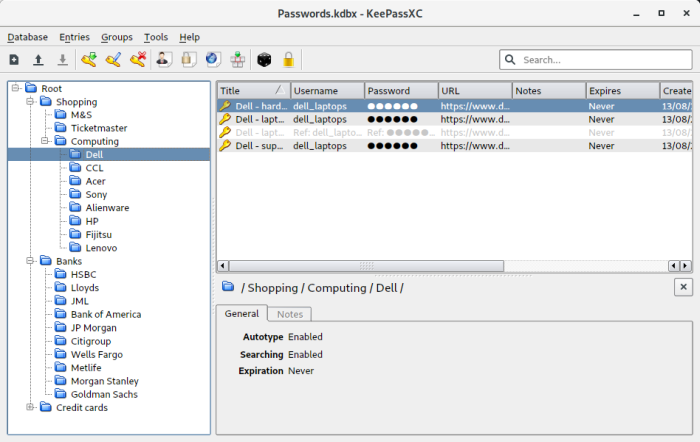- KeeWeb is something that I will keep an eye on definitely to see if creating your own self-hosted version of the application improves or is made clearer on the project website so that anyone with a Dropbox account but no knowledge of scripting or programming languages or Dropbox application creation can set it up on their own.
- Desktop apps for all platforms. Desktop apps look beautiful on each platform: macOS, Windows and Linux. You can open local files in Desktop apps.
- The Nextcloud App Store - Upload your apps and install new apps onto your Nextcloud.
This brief tutorial shows students and new users how to easily install KeyWeb password manager on Ubuntu 20.04 | 18.04.
KeeWeb Password Database. Russian language in KeeWeb is installed using plugins. Yes, there are plugins here, which I will discuss below. KeeWeb Features. Talking about all the features of KeeWeb, I do not see the point. Everything you are used to at KeePass is here. This is a complete password manager with all the necessary features.
KeeWeb is a free, cross-platform password manager that is compatible with KeePass. It helps you store your password online as well as offline securely.
With KeeWeb, you can sync your password automatically with popular cloud services, including OneDrive, Google Drive, Dropbox and many others.
It supports multiple features, including user-friendly desktop interface, multiple themes, multiple files supports, drag n’ drop, password generator and more.
To get started with installing KeeWeb, follow the steps below:
Prepare Ubuntu
Before installing KeeWeb on Ubuntu, run the commands to install required and recommended packages.
After running the command above, continue below to installing KeeWeb.
Install Docker

Now that you’ve installed the recommended packages above, continue below and install Docker.
Docker is required to run KeeWeb. For this post, we’re going to be installing Docker CE (Community Edition).
First add Docker repository key to your system by running the commands below:
Then run the commands below to add Docker repository
Next, run the commands below to install Docker CE.
To validate that Docker is installed run the commands below:
That should display the Docker version installed.
To run Docker as a non-root user, add your user account to Docker’s group by running the commands below:
Keeweb Open Source
You may also want to restart your machine just to be sure.
Keepass 2
Install KeeWeb
Now that Docker is installed, run the commands below to get KeeWeb packages from git repostory.
Next, run the commands below to download all neccessary docker packages that are required to run KeeWeb.

Then run the commands below to create a container for KeeWeb from the downloaded image and expose it on port 80.
You can check that the container is running by running the commands below:
That should display similar lines as below:
Access KeeWeb
Now that KeeWeb is installed, browse to the server hostname or IP address to load KeeWeb portal.
You can now begin entering your secure password entries. Click the Plus ( + ) to start.
Then click New to create a new file entry.
That should do it!
Conclusion:
This post showed you how to install KeeWeb Password Manager on Ubuntu. If you find any error above, please use the form below to report.
You may also like the post below:
How do you secure your login and password information? You could simply rely on your web browser, but there are so many other locations which might require a secure login, away from your browser.
Keeweb Vs Keepassxc
You could choose a commercial password manager, such as our choice, 1Password. This cross-platform tool enables you to secure your logins, passwords, personal information and even your credit card details, across your devices. If you're on your smartphone out and about, you can view your login details from 1Password just by using Face ID. The only issue is, this isn't a cheap service requiring an ongoing monthly payment for you to keep accessing your own password information.
Keeweb Github
KeeWeb is a free opensource cross-platform alternative which is built on top of the popular KeePass technology. The difference with KeeWeb is that the UI looks like a modern implementation and we're impressed. It even includes the option of a dark mode by default and the developer has cleverly designed it so it looks the same across Mac, Windows or Linux computers.
As you would expect with a password manager, you can store your login, password, credit cards and other personal data. KeeWeb supports Dropbox synchronisation, so if you move from your office Windows PC to your Mac laptop, your information will be in sync. You can assign tags so you can quickly find information and add colour favourites so separate information.
You also get a password generator, making it easy to create a secure password if a website or other location requires a secure login. You can add inline images, so if you feel compelled, you can even add an image of your credit card to KeeWeb.
The major downside of using KeeWeb is that there are no smartphone apps, meaning you can't manage your passwords from your iPhone or Android device. What you can do is open a web browser app and load your Dropbox stored data via your browser, but's not the ideal solution.
As KeeWeb is opensource, we might see additional functionality added in future. Third-party developers have created their own themes and there's even a 'Have I Been Pwned?' plugin made available so you can check whether any of your logins/passes have been compromised.

Verdict:
Keeweb Chrome Extension
Looks great, cross-platform, free and with lots of potential. For us though, we'd love a smartphone app, but for a free password manager, that's a tall ask. Give it a try.

